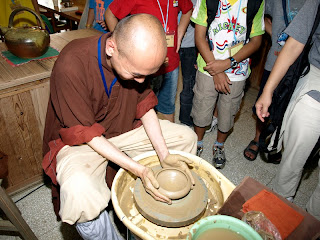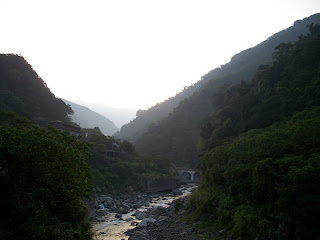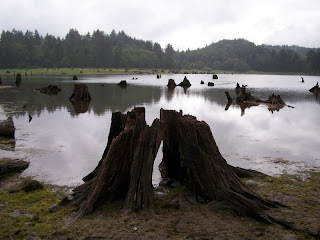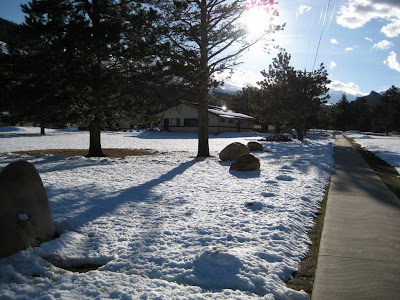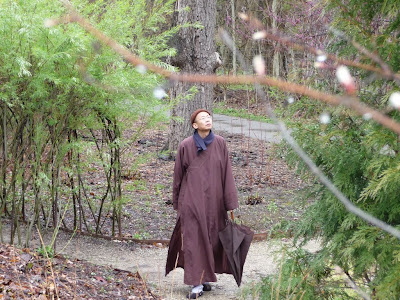Buddha Jewel Monastery was featured in the local newspaper. We thank Mr. Mike Millon of the
South Seattle Beacon for this interview and a nice report, as well as giving the permission to reprint it here and in our websites.
Buddha Jewel Monastery: A new neighbor on the blockBy Mike Dillon |
| ■ An old church with a troubled past is now Buddha Jewel Monastery, a Zen Buddhist religious community that is reaching out to the community. photo courtesy of Buddha Jewel Monastery |
 |
| ■ The Venerable Jian Hu left a high-paying job in the aerospace industry to pursue the meaning of life. photo courtesy of Buddha Jewel Monastery |
For years the church near the intersection of South Kenyon Street and Rainier Avenue South had been a source of neighborhood concern: in-house financial improprieties, loudspeaker evangelicalism and a deteriorating building.
How things have changed.
Buddha Jewel Monastery, 7930 Rainier Ave. S., opened at the site last September. All it took was an outreach effort from the well-established Chung Tai Monastery in Taiwan and an abbot with a doctorate in computer science who renounced the blandishments of the world in order to explore the meaning of life.
The abbot is the Venerable Jian Hu, 45. Hu lives on the premises with three other brown-robed monks and has reached out to the community with free classes on Zen meditation (see sidebar).
Hu came to the United States as a teenager and graduated from high school in Las Vegas. He went on to earn a degree from the California Institute of Technology and completed his doctorate at the University of California, San Diego. A well-paid job in the aerospace industry followed.
"It was a good job," Hu recalled, "but I felt something was lacking. In college I asked myself questions: What is the meaning of life?"
As an undergrad, his reading delved into philosophy and religion. "When I dug into Zen Buddhism, it made sense to me - not only as a belief but as a practice. When your perspective changes, your world changes."
Hu, soft-spoken, focused, formally polite and quick to laugh, returned to Taiwan to study with the noted Chinese Zen master Wei Chueh.
Zen discipline, which includes meditation, is focused on seeing into the nature of reality or, as the Zen saying goes, not mistaking the finger pointing to the moon for the moon itself.
The practice traces its roots to China, where it flourished around 700 A.D. In this country Zen surfaced in mainstream American culture after World War II. One of its Western pioneers, British citizen Reginald Blyth, traveled to pre-war Japan to study Zen and found himself interned during the war. After the war he tutored the Crown Prince.
His ground-breaking, quirky, five-volume "Zen and Zen Classics" caught the attention of American students of Zen, like author Allen Watts, Catholic monk Thomas Merton and literary vagabond Jack Kerouac.
Blyth wrote: "What is Zen? Zen means doing anything perfectly - making mistakes perfectly, hesitating perfectly, having stomachache perfectly. 'Perfectly' means that the activity is harmonious in all its parts."
Blyth's words are a perfectly Western permutation, of course. Asian Zen Buddhist practitioners look to their ancient, sacred scriptures and logic-twisting koans to put them on the road to enlightenment.
As Hu noted, enlightenment does not mean "a serene daze, but a clear, quiet mind that allows for kindness and compassion" - qualities that perhaps take on more urgency in the current economic climate.
"Being fully aware of the present," Hu observed, "you can see opportunities. You can explore behind the suffering and fear."
Hu said the home monastery in Taiwan financially supported the creation of its Seattle chapter, but he expects his monastery to be financially self-sustaining.
The monastery and grounds occupy 1.5 acres. Inside, the ambience is one of simplicity with ornate touches. The meditation hall - the main space with a large altar where a statue of Buddha presides - is the site for services and meditation classes.
An upstairs library houses Chinese texts and artwork. In the basement there's a dining hall and - the modern world breaking in on timeless simplicity - a computer room. Hu smiles at the irony, but then irony has a home in Zen practice.
Out in front two lion statues face Rainier Avenue South. Hu said lions figure in Buddhist belief: People are apt to listen to their roar as they would the truth.
A rock garden is under construction, and there are plans under way for a Chinese garden that would be open to the public.
Frank Kliewer, 62, attends services at the monastery. He is also an artist and former Christian preacher who is a consultant on the landscape work.
"People of all faiths come by and are pleased by the building and what's going on," he said. "It brings a totally different spirit to the neighborhood."











